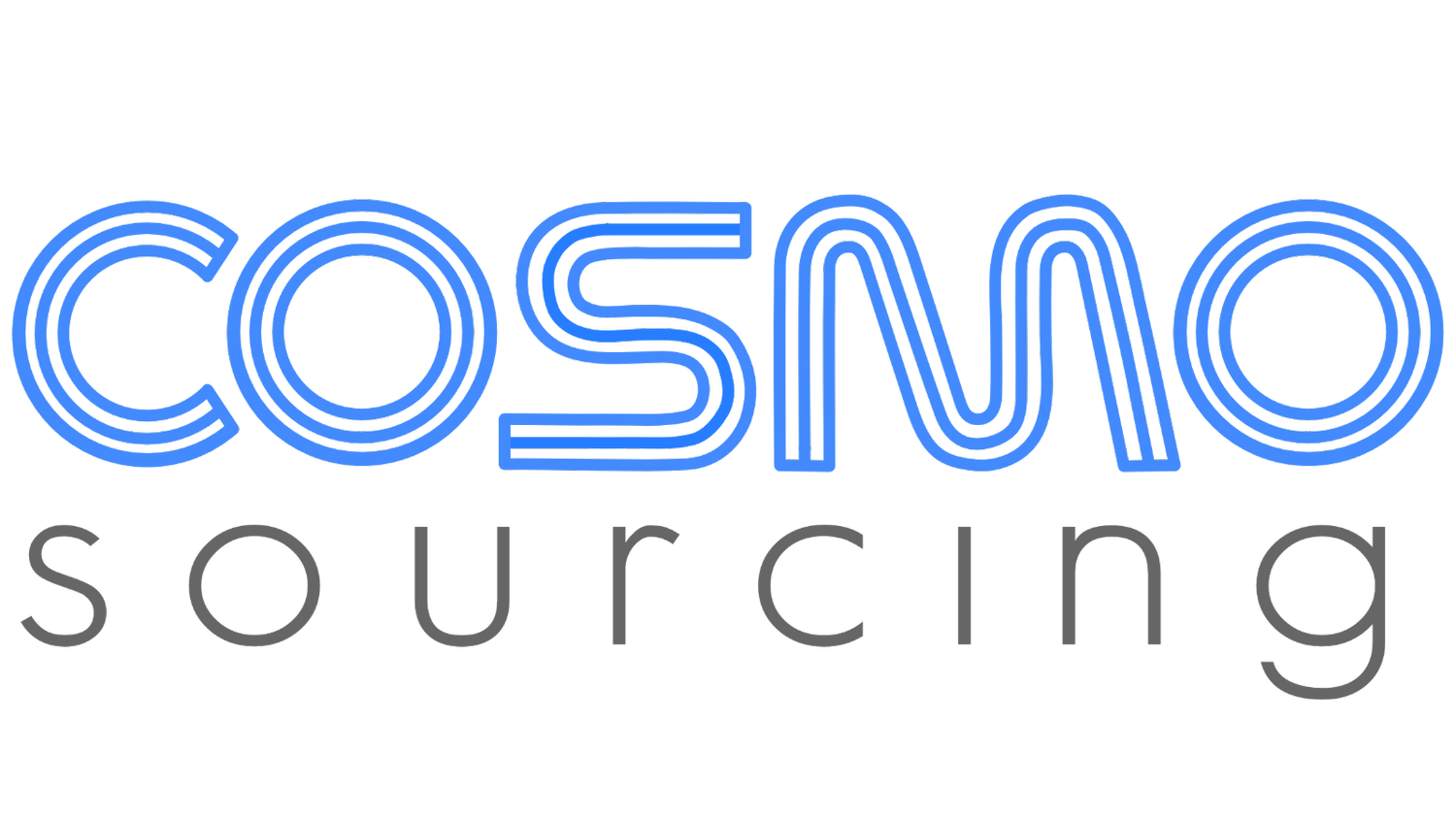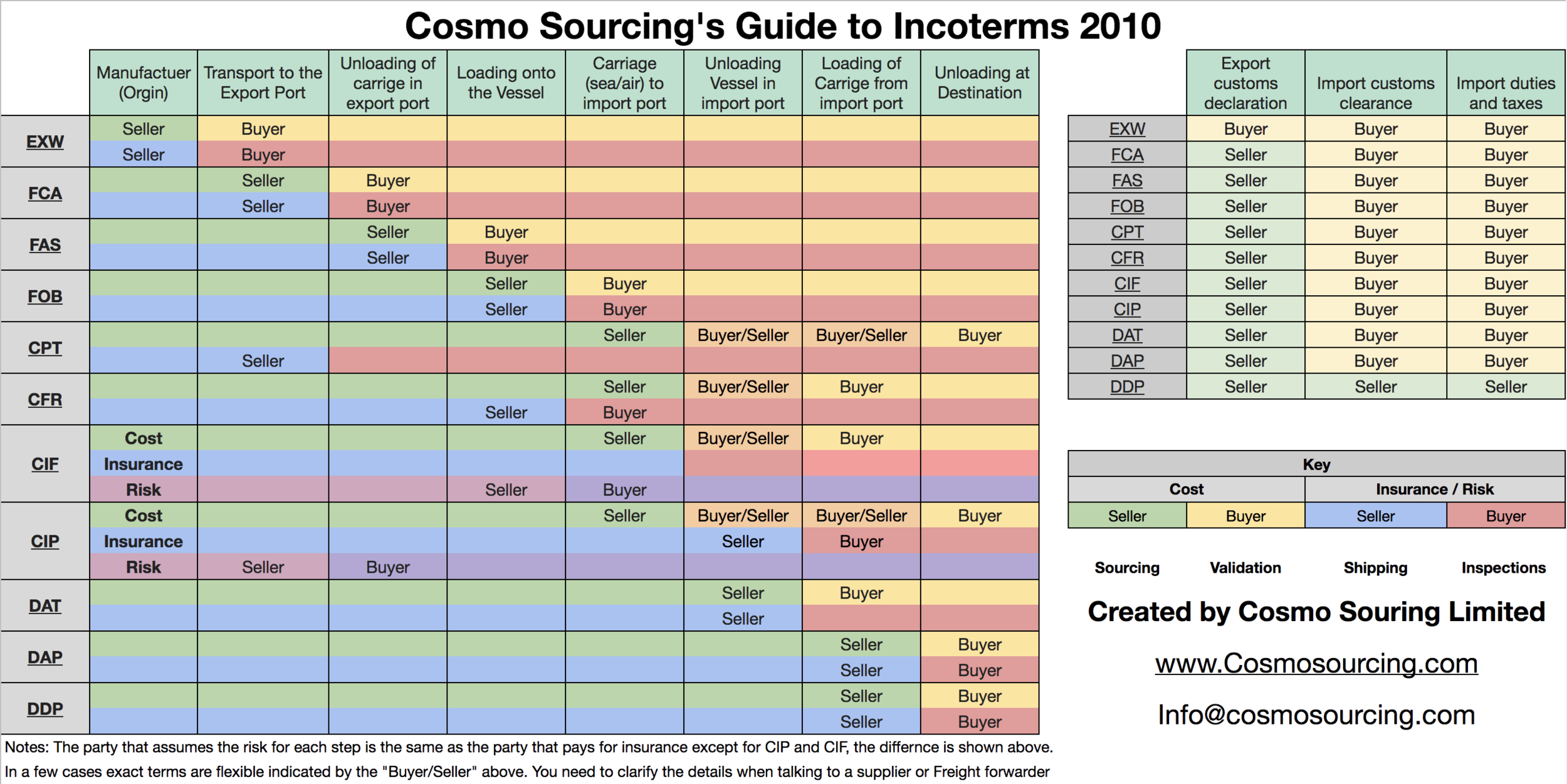Incoterms, Shipping, and Trade Terms Defined // FOB, EXW, FCA, CPT, CIP, DDP, etc.
Are you unsure about the trade terms of Alibaba or Chinese suppliers? Don't know what the three letters that came with your quote mean? Cosmo has defined the 2010 Incoterms abbreviations, such as FOB, CFR, and DAP, for international trade.
When obtaining quotes from suppliers, they will typically provide three pieces of information: the price per unit, the minimum order quantity (MOQ), and the shipping terms. The shipping terms, Incoterms, are typically denoted by three letters at the end of the term. For instance, I recently received the following quote: "1000-1.75/pc, 2000-1.65/pc, 10000-1.50/pc, EXW." In this case, EXW stands for Ex-Works, which defines the shipping terms and the obligations of both the Buyer and the seller to deliver the product to its final destination. People often ask us if Alibaba prices include shipping. The answer is no – they almost always quote prices EXW on the website.
[UPDATE] Click here for the new Incoterms 2020
Incoterms are international trade or shipping terms, often referred to as contracts of sale. Incoterms are short for International Commercial Terms, EXW and FOB, and are far from the two most common incoterms. Incoterms have two parties, 'the buyer and 'the seller.' 'The seller' is typically a factory, manufacturer, trading company, or wholesaler. The Buyer is the person who purchases the goods from overseas and imports them for final sale. If you run an FBA business, you will be classified as the Buyer in these examples. This guide is for the most recent Incoterms, updated in 2010. There are now 11 recognized terms, down from 13 in 2000. Incoterms are published by the International Chamber of Commerce (ICC), which holds the copyright to these terms.
Steps of the shipping process
Ten steps in the shipping process must be completed to transport a product from a factory to its final destination.
Transport to the export port
Unloading the carriage at the export port
Loading onto the vessel
Export customs clearance (to clear for export)
Shipping on the vessel (such as ocean shipping or air)
Unloading the vessel at the import port
Import customs and clearance
Import duties and taxes
Loading of the carriage in the import port
Unloading at the destination (terminal)
The Buyer defines the final destination, and if you are an FBA seller, that typically would be either Amazon's warehouse or a prep and ship center. The Incoterms explain who is responsible for doing each action. For example, it's widespread for a buyer or seller to hire a freight forwarder to do the shipping for them.
Note about freight forwarder:
We should note that most shipping steps are not performed by the seller or the Buyer, but rather by a freight forwarder. However, depending on the trade terms, the Buyer or seller must find and pay a freight forwarder.
Trade terms defined
Before we get into the Incoterms, there are a few words that need to be defined:
Seller: Typically, the manufacturer, trading company, or wholesaler supplying the goods for sale.
Buyer: The person purchasing the goods will receive them upon final delivery.
Delivery: The point at which the risk is transferred from the seller to the Buyer.
Arrival: The point when the delivery has been paid for. The seller should name the place.
Free: How far is the seller obligated to deliver the goods to be picked up by the Buyer?
Carrier: The party that is obligated to transport the goods. This can be done by any means necessary, for instance, by ship, rail, or truck.
Freight Forwarder: A firm that is commonly contracted to make shipping arrangements.
To Clear for export: When export permission is granted.
Terminal: The shipment's final destination, such as a dock or warehouse. For FBA sellers, this is most commonly an Amazon fulfillment center.
Incoterms defined
As EXW and FOB are the most common, we’ll start there. When we request initial quotes from manufacturers in our RFQs, we ask them to quote prices in EXW and FOB terms. Why? We would like to know the EXW price, as that is the price of the product itself. The FOB is used to gauge shipping prices, as the export port is a convenient location for our freight forwarder to collect items. Most of our projects are FOB; we contract with a freight forwarder to complete the remaining shipping.
EXW- Ex-Works
FOB is the most basic shipping Incoterm that a supplier can provide. The seller makes the item available for pickup at the factory and is not responsible for the product once it leaves the factory premises. Instead, the buyer is responsible for transporting it from the factory, covering all export and import clearances and insurance costs.
Suppose you are getting initial quotes from a factory for the first time. In that case, they will almost always provide you with a quote for EXW unless you explicitly request an alternative term. Factories and suppliers usually quote in EXW because it’s their lowest price, and it appears favorable when comparing quotes and seeking the lowest price.
FOB - Free on Board
FOB means that the seller ships the goods to the nearest port, and the seller is responsible for everything after that. The seller will drop this off at the port of shipment, and the buyer will either pick it up themselves or, more commonly, work with a freight forwarder to ship it for them. The seller is responsible for clearing the goods for export, and the buyer is responsible for the goods from the port onwards. Therefore, it’s essential when obtaining FOB quotes to ensure you obtain the port’s name where the goods are dropped off.
One of the primary reasons this is the most popular Incoterm is that the Export port is an ideal location for a third-party inspection service to inspect the goods. Further, the seller is responsible for all activities in the country of export. Simultaneously, the buyer is responsible for all activities once the goods leave the country, which simplifies things. In addition, most freight forwarders will have an office at or near the port, and it’s an easy spot for them to pick up the goods on your behalf.
FCA - Free Carrier
FCA is just one step up from EXW, in which the seller clears the goods for export and delivers the goods to the port of export. Next, the buyer must unload the goods at the port and is responsible for them once they arrive. Next, the buyer arranges the carrier. The most significant difference between EXW and EXW is that the seller must load the goods on the buyer’s carrier. It should be noted that this is often confused with FOB; feel free to ask your supplier to elaborate and provide details.
CPT - Carriage Paid To
The seller pays for the goods shipped to the buyer’s chosen port of import. The risk is transferred to the buyer upon arrival of the goods at the port. The buyer is responsible for unloading the vessel and arranging further transportation. Even though the seller is responsible for the cost of the export port, the buyer assumes the risk and insurance costs once the goods are unloaded at the export port. The seller is responsible for obtaining export clearance and covering the freight costs.
CIP - Carriage and Insurance Paid To
It is effectively the same as CPT, except the seller is required to obtain insurance for the goods during transit. CIP also covers all modes of transportation, while CIF is specifically for sea freight. We should note that CIP and CIF are the only ways in which risk and insurance differ. Once the goods are unloaded at the export port, the seller assumes the insurance cost but not the risk until the goods are unloaded at the import port.
DAT - Delivered at Terminal
The seller delivers the goods (unloaded) to the port of import, and the buyer is responsible for the cost and risk of the goods from that point onward. The seller assumes all risks and costs associated with the goods until they reach the port of import. Then, the buyer pays for imports and customs.
DAP - Delivered at Place
The seller delivers the goods to the buyer’s final destination. The seller assumes all risks associated with shipping and either loads the goods themselves or pays a third party to load the goods for shipment. The buyer is only responsible for paying the customs fee and clearing the goods for import. The buyer also pays to unload the goods at the final destination.
DDP - Delivered Duty Paid
With these terms, the seller pays for and is responsible for everything. The seller pays all costs and assumes all risks to the final destination. The buyer is only responsible for unloading the goods once they arrive at the final destination chosen by the buyer.
We are often asked why we don’t get every project DDP. While it is the easiest for the buyer, it is certainly not the cheapest. The seller selects the shipping company and will choose the one they prefer, not necessarily the cheapest or most reliable for you. You are placing a great deal of trust in the shipping company. I would suggest getting a quote for DDP from your supplier, a quote for FOB, and a quote from a freight forwarder, and then comparing the final total price of the two.
Note: FOB, FAS, CFR, and CIF are specifically applicable to waterway-based shipments (both ocean and inland waterways), whereas the above terms apply to all forms of shipping, including water. Other forms of transportation can include rail, trucking, or air cargo.
FAS - Free Alongside Ship
The seller is responsible for delivering all goods to the vessel’s side at the named port of export. The seller pays for and assumes all risks until the goods are loaded onto the ship and cleared for export. The buyer then assumes all costs and risks from that point forward, including loading the ship. This has one less step than FOB, in which the buyer bears the cost and risk of loading the ship onto the vessel.
CFR - Cost and Freight
The seller is responsible for bearing the shipping cost until the named import port. However, the risk is given to the buyer once the goods are loaded onto the ship at the export port and finally delivered from the destination port. This is similar to CPT, except that CFR is specifically designed for water-based transport.
CIF - Cost Insurance and Freight
It is similar to the one above, except that the buyer will require the seller to assume the risk or obtain insurance for the goods until they reach the port of destination. The seller bears all shipping costs and assumes the risk of the goods until the destination port. The seller is also responsible for clearing customs, but the buyer is responsible for paying the duty. Again, this is effectively the same as CIP, except CIF is specifically for water.
Sourcing Kit: Take Control of Your Sourcing!
Are you ready to take control of your sourcing process and confidently navigate Incoterms? Sign up for the Sourcing Kit today and gain access to an array of invaluable resources designed to streamline your sourcing journey. Our comprehensive toolkit includes detailed contract templates, step-by-step self-guided courses, practical scripts, and more.
Don’t let the complexities of global sourcing hold you back. Empower yourself with the knowledge and tools you need for a seamless, successful sourcing experience. Click here to get started with the Sourcing Kit and transform your connections with top manufacturers in China and Vietnam. Your path to sourcing excellence begins today!


